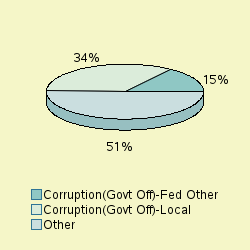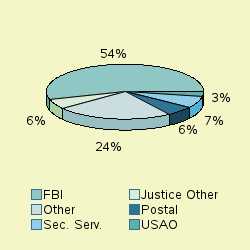
Official Corruption Prosecutions for 2023
Number Year-to-date 252 Percent Change from previous year -2.3 Percent Change from 5 years ago -3.1 Percent Change from 10 years ago -40.6 Percent Change from 20 years ago -50.6
Table 1: Criminal Official Corruption ProsecutionsThe latest available data from the Justice Department show that during the first eight months of FY 2023 the government reported 252 new official corruption prosecutions. If this activity continues at the same pace, the annual total of prosecutions will be 378 for this fiscal year. According to the case-by-case information analyzed by the Transactional Records Access Clearinghouse (TRAC), this estimate is down 2.3% over the past fiscal year when the number of prosecutions totaled 387.
The comparisons of the number of defendants charged with official corruption- offenses are based on case-by-case information obtained by TRAC under the Freedom of Information Act from the Executive Office for United States Attorneys (see Table 1).
Compared to five years ago when there were 390, the estimate of FY 2023 prosecutions of this type is down 3.1 percent. Prosecutions over the past year are lower than they were ten years ago. Overall, the data show that prosecutions of this type are down 40.6 percent from the level of 636 reported in 2013 and down 50.6 percent from the level of 765 reported in 2003.
The long term trend in official corruption prosecutions for these matters going back to FY 2003 is shown more clearly in Figure 1. The vertical bars in Figure 1 represent the number of official corruption prosecutions of this type recorded each fiscal year. Projected figures for the current fiscal year are shown. Each presidential administration is distinguished by the color of the bars. To view trends month-by-month rather than year-by-year, see TRAC's monthly report series for the latest data.
Leading Program Categories
Within the broad category of official corruption, cases were classified by prosecutors into more specific types.
Case types within official corruption are
Corruption(Govt Off)-Fed Law Enforcement
Corruption(Govt Off)-Fed Other
Corruption(Govt Off)-Fed Procurement
Corruption(Govt Off)-Fed Program
Corruption(Govt Off)-Local
Corruption(Govt Off)-Other
Corruption(Govt Off)-State
The single largest number of prosecutions of these matters through May 2023 was for "Corruption(Govt Off)-Local", accounting for 34.1 percent of prosecutions.
As shown in Figure 2, the second largest number of matters were prosecutions filed under the program area of "Corruption(Govt Off)-Fed Other " (15.1%) . The "Other" category in Figure 2 is comprised of a diverse group of programs. The largest specific programs within the "Other" category were: Corruption(Govt Off)-Fed Program" (14.7%), "Corruption(Govt Off)-Other" (10.3%), "Corruption(Govt Off)-State" (9.9%), "Corruption(Govt Off)-Fed Law Enforcement" (9.5%), "Corruption(Govt Off)-Fed Procurement" (6.3%). See Figure 2.
Leading Investigative Agencies
The lead investigative agency for official corruption prosecutions through May 2023 was "Justice - Federal Bureau of Investigation" accounting for 54.4 percent of prosecutions referred.
As shown in Figure 3, additional agencies with substantial numbers of official corruption referrals were: Homeland Security - Secret Service (formerly Treasury) (6.7%), "Justice - Other" (6%), "Postal Service" (6%), "Other - USAO District Transfer" (2.8%).
Top Ranked Lead Charges
Table 2 shows the top lead charges recorded in the prosecutions of official corruption matters filed in U.S. District Court during the first eight months of FY 2023.
Note: There were an additional 101 other lead charges which were not individually ranked. See latest monthly report if you want all lead charges included in rankings for the latest month, or use TRACFED criminal analyzer tool for complete listing for any year.
Lead Charge Count Rank 1 yr ago 5 yrs ago 10 yrs ago 20 yrs ago 18 USC 1343 - Fraud by wire, radio, or television 57 1 2 4 8 12 More 18 USC 666 - Theft or bribery in programs receiving Fed funds 40 2 1 1 1 1 More 18 USC 201 - Bribery of public officials and witnesses 25 3 4 3 2 3 More 18 USC 371 - Conspiracy to commit offense or to defraud US 19 4 3 2 7 2 More 18 USC 1952 - Racketeering -interstate/foreign travel/transport 14 5 5 35 35 55 More 18 USC 641 - Public money, property or records 13 6 5 6 6 4 More Other US Code Section 12 7 22 11 16 23 More 18 USC 1344 - Bank Fraud 10 8 18 20 26 92 More 18 USC 1341 - Mail Fraud - Frauds and swindles 6 9 15 12 5 6 More 18 USC 1709 - Theft of mail matter by officer or employee 6 9 11 7 11 13 More 18 USC 1951 - Hobbs Act 6 9 10 5 4 5 More
Table 2: Top charges filed
"Fraud by wire, radio, or television" (Title 18 U.S.C Section 1343) was the most frequent recorded lead charge. Title 18 U.S.C Section 1343 was ranked 2nd a year ago, while it was the 4th most frequently invoked five years ago. It was ranked 8th ten years ago and 12th twenty years ago.
Ranked 2nd in frequency was the lead charge "Theft or bribery in programs receiving Fed funds" under Title 18 U.S.C Section 666. Title 18 U.S.C Section 666 was ranked 1st a year ago, while it was the 1st most frequently invoked five years ago. It was ranked 1st ten years ago and 1st twenty years ago.
Ranked 3rd was "Bribery of public officials and witnesses" under Title 18 U.S.C Section 201. Title 18 U.S.C Section 201 was ranked 4th a year ago, while it was the 3rd most frequently invoked five years ago. It was ranked 2nd ten years ago and 3rd twenty years ago.
Again among the top ten lead charges, the one showing the sharpest projected decline in prosecutions compared to one year ago—down -39 percent—was "Conspiracy to commit offense or to defraud US " (Title 18 U.S.C Section 371 ). This was the same statute that had the largest projected decrease—-67%—when compared with five years ago.
Judicial District Percapita Count Rank 1yr ago 5yrs ago 10yrs ago 20yrs ago Miss, N 36 26 1 6 24 15 18 More D. C. 13 6 2 1 1 1 1 More Miss, S 6 8 3 11 9 10 6 More N. Y., S 5 17 4 5 10 9 21 More N. Y., E 4 25 5 3 19 45 27 More Nebraska 4 5 6 58 56 29 66 More N Car, M 3 7 7 39 72 74 74 More Mich, W 3 7 8 58 43 65 25 More Fla, M 2 20 9 48 71 62 46 More Mo, W 2 5 10 16 6 22 49 More
Table 3: Top 10 districts (per one million people)
Recent entries to the top 10 list were Southern District of Mississippi (Jackson), Western District of Missouri (Kansas City), Middle District of North Carolina (Greensboro), Middle District of Florida (Tampa), Nebraska and Western District of Michigan (Grand Rapids), now ranked 3rd, 10th, 7th, 9th, 6th and 8th. These districts ranked 11th, 16th, 39th, 48th, 58th and 58th one year ago and 9th, 6th, 72nd, 71st, 56th and 43rd five years ago.
Compared to 10 years ago, Northern District of Mississippi (Oxford), Western District of Missouri (Kansas City), Nebraska, Eastern District of New York (Brooklyn), Middle District of Florida (Tampa), Western District of Michigan (Grand Rapids) and Middle District of North Carolina (Greensboro) now ranked in the top 10 did not appear in the top ten.
And compared to 20 years ago, Northern District of Mississippi (Oxford), Southern District of New York (Manhattan), Western District of Michigan (Grand Rapids), Eastern District of New York (Brooklyn), Middle District of Florida (Tampa), Western District of Missouri (Kansas City), Nebraska and Middle District of North Carolina (Greensboro) were not sufficiently active to then make the top 10.
The federal judicial district which showed the greatest projected growth in the rate of official corruption prosecutions compared to one year ago—875 percent—was Northern District of Mississippi (Oxford). Compared to five years ago, the district with the largest projected growth—2916 percent—was Middle District of Florida (Tampa) .
In the last year, the judicial District Court recording the largest projected drop in the rate of official corruption prosecutions—40.5 percent—was Eastern District of New York (Brooklyn).
Report Generated: July 16, 2023



